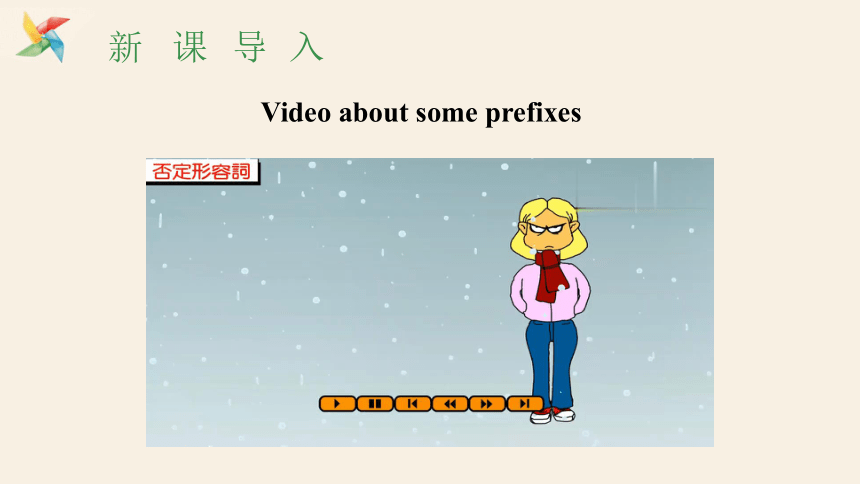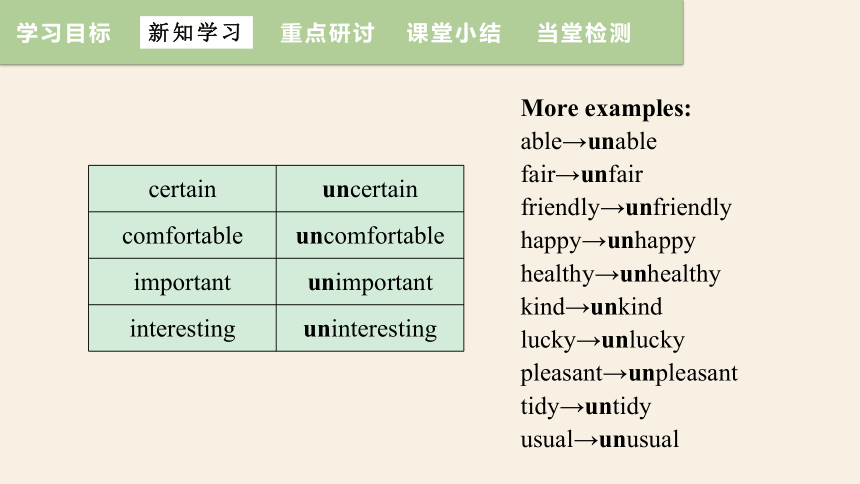Unit 4 Do it yourself Period 5 Study skills 课件(14张PPT,内嵌音频) 2023-2024学年牛津译林版英语八年级上册
文档属性
| 名称 | Unit 4 Do it yourself Period 5 Study skills 课件(14张PPT,内嵌音频) 2023-2024学年牛津译林版英语八年级上册 |  | |
| 格式 | pptx | ||
| 文件大小 | 17.1MB | ||
| 资源类型 | 教案 | ||
| 版本资源 | 牛津译林版 | ||
| 科目 | 英语 | ||
| 更新时间 | 2023-12-23 12:23:41 | ||
图片预览







文档简介
(共14张PPT)
Unit 4
Do it yourself
Period 5
Study skills
新
课
导
入
Video about some prefixes
Language Goal
新知学习
课堂小结
当堂检测
学习目标
重点研讨
1. 能熟悉并正确运用本课时的重点单词和短语。
2. 能掌握在形容词前加前缀un-、in-和im-构成其
反义形容词的方法。
新知学习
课堂小结
当堂检测
学习目标
重点研讨
A prefix is a letter or a group of letters that we add to the front of a word to form a new word.
One of the most common prefixes for adjectives is un-. It means “not”. We add it to some adjectives to give them the opposite meaning.
The prefixes un-, in- and im-
新知学习
课堂小结
当堂检测
学习目标
重点研讨
certain uncertain
comfortable uncomfortable
important unimportant
interesting uninteresting
More examples:
able→unable
fair→unfair
friendly→unfriendly
happy→unhappy
healthy→unhealthy
kind→unkind
lucky→unlucky
pleasant→unpleasant
tidy→untidy
usual→unusual
新知学习
课堂小结
当堂检测
学习目标
重点研讨
We can also use some other prefixes, such as in- and im-, to form new words with the opposite meaning.
active inactive
correct incorrect
patient impatient
possible impossible
More examples:
complete→incomplete
direct→indirect
polite→impolite
proper→improper
新知学习
课堂小结
当堂检测
学习目标
重点研讨
Read the conversations below. Add the correct prefixes to some of the adjectives so that the sentences make sense.
A
▲
1. Annie: Do you spend a lot of time doing outdoor sports
Simon: Sure. It’s usual for me to stay at home all day.
2. Sandy: Our neighbour next door is putting something on
the wall.
Mum: It’s possible to sleep with all that noise.
unusual
impossible
新知学习
课堂小结
当堂检测
学习目标
重点研讨
3. Millie: Are you able to fix your bicycle, Andy
Andy: No. I’m certain that I can fix it myself.
4. Mum: Suzy, your room is really tidy —things
are all over the floor.
Suzy: Sorry, Mum. I’ll tidy up right now.
untidy
uncertain
新知学习
课堂小结
当堂检测
学习目标
重点研讨
Language Points
1. Add the correct prefixes to some of the
adjectives so that the sentences make sense.
make sense 讲得通,有意义
e.g. The sentence doesn't make sense.
这个句子讲不通。
tidy up 收拾妥,整理好
e.g. Let's tidy up the room.
我们把屋子收拾一下。
2. I’ll tidy up right now.
un-、im-和in-前缀
新知学习
课堂小结
当堂检测
学习目标
重点研讨
前缀是指添加在一个单词前形成一个新的单词的一个字母或者一组字母。
un-是最常见的形容词前缀之一。它的意思是“不”。我们把它加到一些形容词中,赋予它们相反的意思。
除了un-,我们也可以使用一些其他的前缀,如in-和im-来组成意思相反的新单词。
其他否定形容词前缀
新知学习
课堂小结
当堂检测
学习目标
重点研讨
除了un-、im-和in-前缀之外,还有一些加在形容词前面形成相反意思的形容词的前缀:
1. dis-
honest (诚实的)→dishonest (不诚实的)
2. ab-
normal (正常的)→abnormal (反常的)
其他否定形容词前缀
新知学习
课堂小结
当堂检测
学习目标
重点研讨
3. ir-
regular (规则的)→irregular (不规则的)
4. il-
legal (合法的)→illegal (不合法的)
5. non-
existent (存在的)→non-existent (不存在的)
新知学习
重点研讨
课堂小结
当堂检测
学习目标
Unit 4
Period 5
前缀un-、im-和in-:
在一些形容词后面加上un-、im-和in-可以形成与当前形容词意思_________的形容词。
重点单词:
certain, active, possible, tidy, tidy up, make sense
相反
新知学习
课堂小结
当堂检测
学习目标
重点研讨
用所给单词的适当形式填空。
1. Don’t be _________ (patient). He is only five years old.
2. It’s ________ (usual) for him to be rude. He is always polite.
3. Nick’s room is really ______ (tidy). His mother is angry with him.
4. It’s very hot today. I feel _____________ (comfortable).
5. The book is _____________ (interest). I will never read it again.
6. The dog was really __________ (friendly) to me. It barked at me
all the time.
impatient
unusual
untidy
uncomfortable
uninteresting
unfriendly
Unit 4
Do it yourself
Period 5
Study skills
新
课
导
入
Video about some prefixes
Language Goal
新知学习
课堂小结
当堂检测
学习目标
重点研讨
1. 能熟悉并正确运用本课时的重点单词和短语。
2. 能掌握在形容词前加前缀un-、in-和im-构成其
反义形容词的方法。
新知学习
课堂小结
当堂检测
学习目标
重点研讨
A prefix is a letter or a group of letters that we add to the front of a word to form a new word.
One of the most common prefixes for adjectives is un-. It means “not”. We add it to some adjectives to give them the opposite meaning.
The prefixes un-, in- and im-
新知学习
课堂小结
当堂检测
学习目标
重点研讨
certain uncertain
comfortable uncomfortable
important unimportant
interesting uninteresting
More examples:
able→unable
fair→unfair
friendly→unfriendly
happy→unhappy
healthy→unhealthy
kind→unkind
lucky→unlucky
pleasant→unpleasant
tidy→untidy
usual→unusual
新知学习
课堂小结
当堂检测
学习目标
重点研讨
We can also use some other prefixes, such as in- and im-, to form new words with the opposite meaning.
active inactive
correct incorrect
patient impatient
possible impossible
More examples:
complete→incomplete
direct→indirect
polite→impolite
proper→improper
新知学习
课堂小结
当堂检测
学习目标
重点研讨
Read the conversations below. Add the correct prefixes to some of the adjectives so that the sentences make sense.
A
▲
1. Annie: Do you spend a lot of time doing outdoor sports
Simon: Sure. It’s usual for me to stay at home all day.
2. Sandy: Our neighbour next door is putting something on
the wall.
Mum: It’s possible to sleep with all that noise.
unusual
impossible
新知学习
课堂小结
当堂检测
学习目标
重点研讨
3. Millie: Are you able to fix your bicycle, Andy
Andy: No. I’m certain that I can fix it myself.
4. Mum: Suzy, your room is really tidy —things
are all over the floor.
Suzy: Sorry, Mum. I’ll tidy up right now.
untidy
uncertain
新知学习
课堂小结
当堂检测
学习目标
重点研讨
Language Points
1. Add the correct prefixes to some of the
adjectives so that the sentences make sense.
make sense 讲得通,有意义
e.g. The sentence doesn't make sense.
这个句子讲不通。
tidy up 收拾妥,整理好
e.g. Let's tidy up the room.
我们把屋子收拾一下。
2. I’ll tidy up right now.
un-、im-和in-前缀
新知学习
课堂小结
当堂检测
学习目标
重点研讨
前缀是指添加在一个单词前形成一个新的单词的一个字母或者一组字母。
un-是最常见的形容词前缀之一。它的意思是“不”。我们把它加到一些形容词中,赋予它们相反的意思。
除了un-,我们也可以使用一些其他的前缀,如in-和im-来组成意思相反的新单词。
其他否定形容词前缀
新知学习
课堂小结
当堂检测
学习目标
重点研讨
除了un-、im-和in-前缀之外,还有一些加在形容词前面形成相反意思的形容词的前缀:
1. dis-
honest (诚实的)→dishonest (不诚实的)
2. ab-
normal (正常的)→abnormal (反常的)
其他否定形容词前缀
新知学习
课堂小结
当堂检测
学习目标
重点研讨
3. ir-
regular (规则的)→irregular (不规则的)
4. il-
legal (合法的)→illegal (不合法的)
5. non-
existent (存在的)→non-existent (不存在的)
新知学习
重点研讨
课堂小结
当堂检测
学习目标
Unit 4
Period 5
前缀un-、im-和in-:
在一些形容词后面加上un-、im-和in-可以形成与当前形容词意思_________的形容词。
重点单词:
certain, active, possible, tidy, tidy up, make sense
相反
新知学习
课堂小结
当堂检测
学习目标
重点研讨
用所给单词的适当形式填空。
1. Don’t be _________ (patient). He is only five years old.
2. It’s ________ (usual) for him to be rude. He is always polite.
3. Nick’s room is really ______ (tidy). His mother is angry with him.
4. It’s very hot today. I feel _____________ (comfortable).
5. The book is _____________ (interest). I will never read it again.
6. The dog was really __________ (friendly) to me. It barked at me
all the time.
impatient
unusual
untidy
uncomfortable
uninteresting
unfriendly
